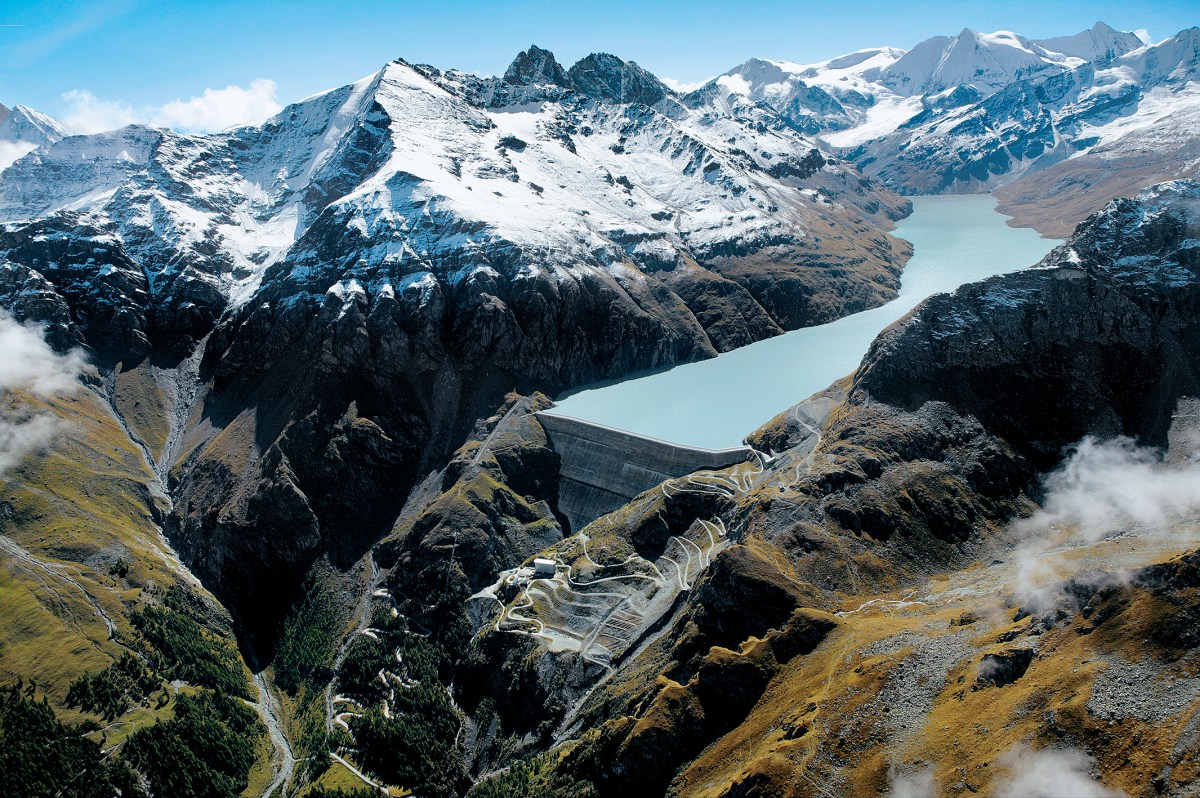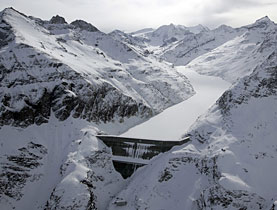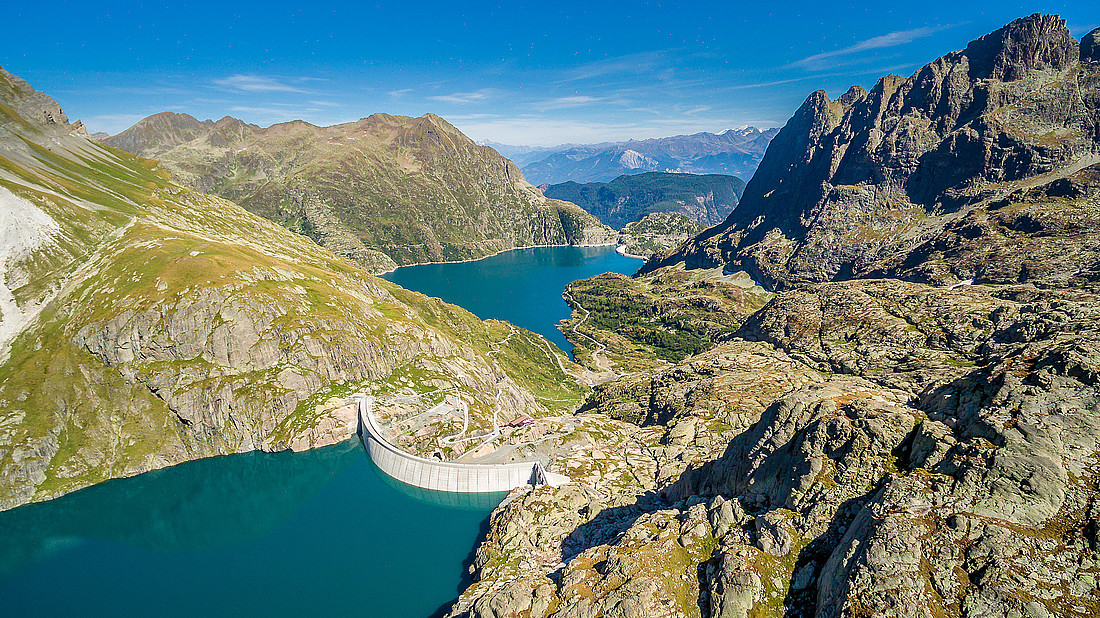
Aerial view of the Grande Dixence dam in canton Valais, Switzerland.
Grand Dixence SA
The Grande Dixence, the world’s tallest gravity dam in the heart of the Swiss Alps, is marking a milestone this year. It helped launch a hydropower revolution in Switzerland, becoming a symbol of Swiss engineering and a cornerstone of the country’s energy strategy.
Built between 1950 and 1961 by 3,000 workers in gruelling conditions, the Grande Dixence is now 75 years old. Here are seven key facts about the spectacular dam and how it has shaped Switzerland.
It’s the tallest gravity dam in the world
Nestled at the head of the Dix Valley in southern Switzerland, the 285-metre-high concrete wall looms into view after a winding hour-long drive up from Sion in the Rhône Valley. While it’s not the world’s tallest dam – that title belongs to China’s Jinping-I (305m) – it is the tallest gravity dam, relying on sheer weight rather than shape to hold back water. The Grande Dixence is Europe’s highest dam and the world’s seventh-tallest overall, slightly shorter than the Eiffel Tower (300 metres).
A gravity dam has a triangular structure, thick at the base and narrow at the top. The Grande Dixence varies in thickness from 15 metres to 200 metres with foundations extending 200m deep and 100m into the sides of the valley. Six million cubic metres of concrete were used – heavier than the great Pyramid of Cheops in Egypt.
It was built over 15 years in tough working conditions
Construction began in 1950 and the dam became fully operational in 1965. Over 3,000 men and women laboured in all weather – snow, cold, storms and blazing sun – in the remote valley.
They mined and sorted rock, mixed cement (800 tonnes brought daily by cable car), and assembled 16-metre by 16-metre concrete blocks like Lego pieces.
>>Check out the historical Grande Dixence gallery below
Work ran seven days a week with 11-hour day shifts or 10-hour night shifts. As it was too far to go home after a shift and accommodation was scare, workers lived in nearby huts and shared beds. Temporary villages had their own hospital, post office, chapel, launderette, libraries and games rooms. Cinema was popular, as were sports. There was a brass band, a gymnastics club, a theatre group and a skiing club.
Most workers came from canton Valais. They were joined by other Swiss nationals, and many Italians as well as citizens of Germany and France. Among them was French-Swiss filmmaker Jean-Luc Godard, who used his earnings to make a short documentary on the construction of the dam called Operation Béton [Operation Concrete].External link
The dam’s reservoir stores 400 million cubic metres of water
Behind the dam wall lies the Lac des Dix, Switzerland’s largest reservoir, holding up to 400 million cubic metres of water. It could fill 160,000 Olympic-sized swimming pools. The water comes from precipitation and meltwater from 35 glaciers across a 420-square-kilometre catchment area stretching from Zermatt to Nendaz.
Climate change will affect Swiss hydropower facilities and reservoirs in particular in the coming decades. While reservoirs are expected to continue filling, allowing their storage capacity to largely buffer seasonal fluctuations in water inflows, the way they are managed will need to adapt. For reservoirs fed by heavily glaciated catchments, such as Grande Dixence, the long-term water supply will gradually decline as glaciers melt away. Additionally, there will be an increase in the influx of loose sediment. To maintain storage capacity, measures will be necessary to prevent these deposits from accumulating.
“We are constantly monitoring inflows – which come equally from precipitation, melting snow and melting glaciers – in order to optimise the management of our power plants and contribute to security of supply,” Céline Kohlprath, spokesperson for the Grande Dixence SA, told Swissinfo.
“The accelerated melting of glaciers is a reality that we have to face up to. Against this backdrop, Alpiq is developing new facilities, such as the Gornerli project [to become part of the Grande Dixence network], which will make the most of this water resource, reduce the risks associated with glacier melt in the valley and enhance the security of water and energy supplies for the future.”
A 2021 studyExternal link by the Federal Office for the Environment estimated that, provided measures are taken to mitigate climate change, annual electricity production from hydropower will barely change in the long term. Without climate change mitigation, though, the amount of energy generated could fall by up to 7% by the end of the century.
The dam’s water flows through 100 kilometres of tunnels
A vast 100-kilometre tunnel network under glaciers and rock channels water to the reservoir. Five pumping stations help transport meltwater from glaciers at lower altitudes up to the 2,400-metre-high main conduit.
Beat Imboden, managing director of Grande Dixence SA, argues that the huge hydropower system was built in harmony with nature and the landscape. “The dam wall and the lake are visible – but everything else was largely built underground,” he told Swiss public radio, SRF.
While Swiss dams stand as remarkable achievements of engineering and symbols of renewable energy success, their construction also tells a story of displacement, expropriation, and resistance. Early opposition came from residents facing the loss of their homes, but since the 1940s, protests have increasingly focused on environmental concerns. Although most efforts to block new hydropower projects through democratic means have failed, the case of the Grande Dixence dam shows that resistance can lead to changes — prompting design modifications and environmental offset measures.External link

The Grande Dixence dam wall is 700 metres long. The dam’s crest reaches an altitude of 2,365 metres.
Alessandro Della Bella / Keystone
The Grande Dixence generates as much electricity as a nuclear power plant
Three hydroelectric plants in the valley convert water into electricity. According to its main shareholder Alpiq, the Grande Dixence hydropower complex produced nearly three terawatt hours (Twh) of electricity in 2024 – equivalent to the production of a medium-sized nuclear power plant or the average annual consumption of 500,000 households (the size of a canton like Bern).
The dam is the backbone of Switzerland’s green energy supply
Switzerland’s geography and high levels of annual rainfall are ideal for hydropower. After early expansion in the 19th century, there was a major boom between 1945 and 1970 as demand for electricity grew. In that period, numerous new power plants were opened in the lowlands, together with large-scale storage plants. Today, Switzerland has more dams than any other country: 222 major dams and around 1,000 smaller ones, plus 704 hydropower plants.
Hydropower once accounted for nearly 90% of domestic electricity production (in the 1970s), but this figure fell to 60% by 1985 following the commissioning of Switzerland’s nuclear power plants. Hydropower is now stable at around 59.5%, and it remains Switzerland’s most important domestic source of renewable energy.External link
Grande Dixence and its 400 million cubic metres of water represents around one-fifth of all national hydropower energy stored in Switzerland, according to Grande Dixence SA.External link But more hydropower is needed. The Swiss federal government aims to boost hydropower output by 2050 to secure future energy supplies, especially in winter. To do this, the government proposes to renovate and expand existing plants, and to construct new ones. It has worked with environmental associations and interest groups to identify 16 dam projects. The largest is the future Gornerli dam and reservoirExternal link, near Zermatt. Integrated into the Grande Dixence system, it could meet the needs of 140,000 households, improve flood protection and supply drinking water. But the Gornerli dam remains controversial and has been contestedExternal link by some environmentalists.
The dam was unscathed by recent rockfall but remains at risk of climate change
In July the Grande Dixence closed to visitors due to a rockfall. Around 5,000 cubic metres of rock came loose above the dam, equivalent to the size of seven houses. Some fell into the reservoir, and some hit the wall. The access road and dam have since re-opened.
“We were concerned because the safety of the road and the people accessing the dam was compromised. On the other hand, we weren’t worried about the stability of the dam, because it’s a fairly minor event compared with the size of the wall,” Amédée Murisier, president of Grande Dixence SA and head of Alpiq Switzerland, told Le Nouvelliste newspaperExternal link.
Recent TikTok videos imagining the possible collapse of the dam were dismissed by Murisier as pure “science fiction”.
“Back in the 1940s, the site was identified as a reliable one for building a dam: the geological conditions are very good and the structure, which is one of the largest in the world, is not exposed to such a risk.”
However, he acknowledged the issues posed by climate change, which have to be continuously monitored and adjusted for. “It is obvious that the mountain is changing a lot and very quickly. The slopes are destabilising and this creates a whole series of risks,” he says.
Grande Dixence SA says it is constantly adapting infrastructure and water intakes to the changing flows as glaciers retreat and working with authorities to improve monitoring and control systems. As well as glacier retreat, it also tracks permafrost changes, increased water volumes and potential debris flows, and detailed modelling of water levels and energy demand under different climate scenarios.
In the decades ahead, climate change is expected to present significant challenges for Murisier and other Swiss dam operators, as rising temperatures, melting glaciers, and unstable slopes take their toll. Still, at 75, the Grande Dixence stands firm – a central pillar of Switzerland’s energy future.
August 25 marks the 75th anniversary of the founding of the Grande Dixence SA company. Two special exhibitions and a book by author Brigitte Kalbermatten have been organised to celebrate.
On August 25, 1950, EOS (Energie Ouest Suisse, later Alpiq) founded the company Grande Dixence SA, to build and operate the hydropower facility to meet growing electricity needs in French-speaking Switzerland.
An estimated 100,000 people visit the dam every year.
Edited by Gabe Bullard/Veronica De Vore
Source link
#Switzerlands #Grande #Dixence #Europes #tallest #dam #measures



